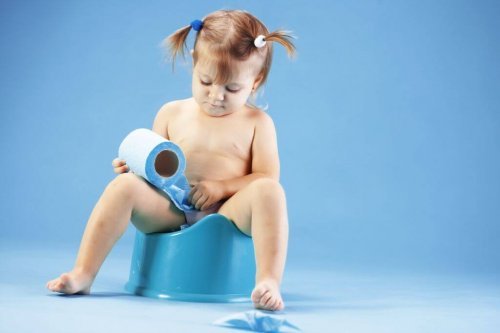Urinary Tract Infections in Girls

Although it’s mostly talked about in women, urinary tract infections in girls are also common. Young girls are also prone to the negative effects this bacteria causes. How can you prevent and treat it?
The urinary system in humans is made up of three organs:
- Urethra, which is the tube where urine goes from the bladder to outside the body.
- Bladder, which is the bag where urine is stored.
- Kidneys, which are responsible for removing waste and water from the blood. Thus, urine forms.
A urinary infection consists of bacteria invading one or more parts of the urinary tract. In addition, fungi, viruses, parasites or microbes can also cause UTI’s.
The area where infection most commonly occurs is in the bladder. Also, the most common way infection spreads is by ascending. That is, it usually starts in the bladder, then moves upward.
Therefore, it’s important to detect UTI’s early to prevent bacteria from reaching the kidneys. There, the infection could cause serious damage.
Causes of urinary tract infections in girls
Urinary tract infections in girls occur most in children under four years old. In addition, it’s one of the most common issues women experience in general. Don’t be too scared, because you can prevent and treat them very easily.
We can explain the main cause of this infection through how the female anatomy is. The urethra is shorter in women, and it’s closer to the anus. For this reason, germs travel a shorter distance to enter the urinary tract.

The bacteria that causes most urinary tract infections is called scherichia coli. It’s a microorganism that lives naturally in our intestines. Therefore, it’s also found in our feces. Because of this, it’s easy for it to spread from the anus to the urethra. This is what causes an infection.
The risk of infection increases significantly when girls wipe from back to front after using the bathroom. Urinary infections occur most often in the summer when it’s hot out.
These are the variables that high temperatures influence:
- Germs multiply faster with heat. The higher the temperature, the faster they grow.
- Heat makes children sweat more, and the volume of urine decreases. In addition to this, if children don’t drink a lot of water, the amount of urine is even smaller. Then, the bacteria that entered have more time to multiply.
- It’s pool season, and bacteria can more easily enter the bladder in the pool. In addition, keeping a wet swimsuit on for a long time makes it easier for bacteria to get into the urethra. The same idea applies to tight clothing.
Symptoms of a urine infection
- Increased frequency and difficulty while urinating
- Sense of urgency to go to the bathroom
- Pain or burning when urinating
- Occasionally, blood in the urine
- Mild fever
- Lower abdomen pain
- Itching or burning in the genitals (if the infection is in the genital area)
“A urinary infection consists of bacteria invading one or more parts of the urinary tract. In addition, fungi, viruses, parasites or microbes can also cause UTI’s.”
Recommendations for parents
There are many good habits you can acquire to reduce the risk of urinary tract infections in girls:
- Teach your children to drink lots of water, and liquids in general. This will help expel bacteria through urine before they cause an infection.
- Teach them the importance of urinating several times a day. Also, they shouldn’t hold it in too long.
- Practice good hygiene habits of the genital area.
- If your daughters are already going to the bathroom alone, make sure they wipe from front to back. They should do this after urinating and defecating.
- If your children still use diapers, make sure to change their diapers regularly. That way, you can prevent humidity. In addition, don’t contaminate the area when changing diapers.
- Quickly change girls out of wet swimsuits.
- Buy loose-fitting cotton underwear.

Doctors diagnose urinary tract infections through a urine test. That way, doctors see if there is any bacteria.
Then, doctors prescribe antibiotics. For very young girls, they might need to spend time in the hospital to receive intravenous medication. Thanks to these medications, the symptoms could improve by the second or third day.
At the end of the treatment, doctors will do another analysis to be sure all the bacteria is gone. In total, treatment lasts about a week.
This text is provided for informational purposes only and does not replace consultation with a professional. If in doubt, consult your specialist.








